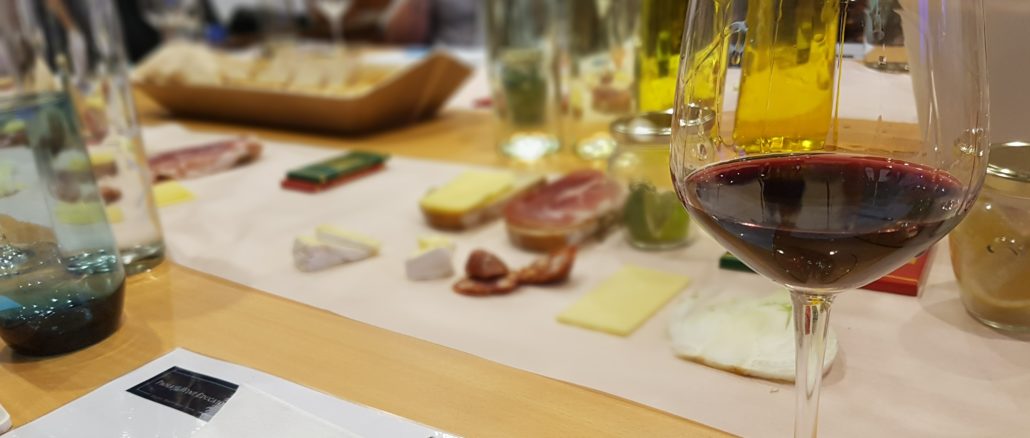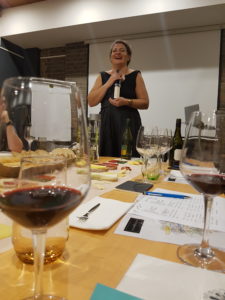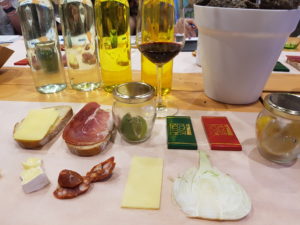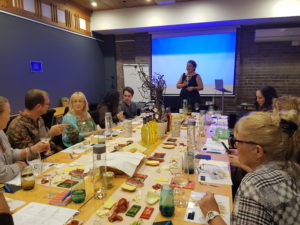
It wasn’t until my mid twenties that I discovered that not all wine tastes like goon.
I now know that I like oaky chardy and I prefer full-bodied reds, but that’s as far as my knowledge has grown since the days of Goon of Fortune.
I’ve always wanted to learn more, because people froth about wine so much that I’ve had long-standing FOMO. What do these swishers and slurpers know that I don’t?
The universe sensed my distress and sent me an invitation to ‘Introduction to Wine Tasting’ evening with QLD’s longest serving female winemaker, the fabulous Paola Cabezas.
 Paola is a smoky-voiced triple threat – as well as being a wine maker, she is also a comedian and a chef. Here are just a few pearls of wisdom that she dropped during our journey into the wonderful world of wine.
Paola is a smoky-voiced triple threat – as well as being a wine maker, she is also a comedian and a chef. Here are just a few pearls of wisdom that she dropped during our journey into the wonderful world of wine.
1. Sauvignon Blanc’s signature scent
The first bottle Paola cracked was a sauv blanc, and it was up to us to identify the scents in our glass. I got all poetic and busted out ‘green apples’, but the majority smelled ‘cut grass’, although Paola assured me that there are no wrong answers.
Paola also told us that the lemony smell coming through was a characteristic of sauv blanc, which was once known for a signature scent of ‘cat piss’. Paolo’s enchanting Argentinian accent somehow made that sound reasonable.
2. The smell changes after you swish
Those people who swirl their wine around are not wankers after all! After our initial sniff, we gave it a swish and the lemon ‘cat piss’ smell was much more prominent.
3. Pair wine with tastes that are similar, or complimentary
Part of our evening with Paola was a first-rate spread of crackers, bread, cheese and cured meats. She urged us to eat as much bread as we wanted from the get go, which is when I knew I loved her.
Under Paola’s tutelage, we combined a mouthful of goat cheese with the bright flavours of the sauv blanc and marveled at the changing sensations in our mouths.
4. Pair complex wine with simple foods, and vice versa
While the flavours should be complimentary, the complexity should not. This is why people love the mild creaminess of Brie with a big ol’ red, or a sweet, light pinot gris with an intense curry.
5. Tannins will make curry taste hotter
Speaking of curry – did you know that tannins (those things in tea and wine that give you cottonmouth) will dry your tongue out and make your curry taste hotter? That’s why you need to choose a rose or pinot gris with your vindaloo.
6. Scent, memory and taste are in bed together
This was my absolute favourite thing we learned. We all know that smells remind us of things, and we all know that everyone’s taste differs. What people don’t realise is how strongly these two are connected.
Paola told us that in England, many people love pinot noir. This lighter red is associated with scents of roses and gardens, which is a constant smell for many people growing up in England. Mind blown!
7. You can sometimes judge a wine by its cover
Ever wondered what those divots at the bottom of the wine bottle are for? Turns out it’s not so that waiters can be fancy when pouring wine; – the divot strengthens the structure of the wine bottle.
If the glass is thicker, the divot has to be deeper. Thick glass is more expensive, so this is a handy rule of thumb for picking a quality bottle.
8. The colours tell a story
You also want to take note of colour, which reveals more than you think. A green tinge indicates a young wine, but too much yellow means the wine may be oxidized.
Colour comes from contact with the grape skins – as in how long the grape juice has been soaked with its skin. A sauv blanc or riesling should have had minimal skin contact, so yellow is a warning sign. In a red you want to avoid anything brown or orange tinted.
9. All grapes are white inside
Ever bitten into a red grape and noticed that it’s white inside? They all are! The aforementioned skin contact is the only thing that gives red wine its rich colour.
10. Price can indicate oakiness
Another rule of thumb to pull out next time you’re at Dan Murphy’s: Paola advises that anything less than the $19 mark has probably not been ‘oaked’.
Oak barrels are hella expensive, so wine that has been aged in wood will cost you more. If you know that wood flavours are your fav, then spend more than $19.
11. Drink champagne in a wine glass
Apparently the champagne flute was a bit of a fashion statement. Sure, it keeps the bubbly bubbly, but how can you sniff it to get the full profile of your champers?
Paola recommends sipping your bubbly from an old fashioned, wide-bowled champers glass, or a simple wine glass.
12. Decant any red over five years old
If I can ever afford a good bottle of wine that’s over five years old, I will decant it thanks to Paola’s tip. I don’t have a decanter, but I feel like I’m a while off this milestone anyway so I will count on my dad’s stock of wine to implement this knowledge.
13. My new favourite wine is made in Stanthorpe
What are the chances? The second white that Paola poured us was the most enticing chardonnay I have ever met. It smelled like buttery popcorn and tasted like coconut and cream.
Paola is the head wine maker at Robert Channon Wines in Stanthorpe, and I am determined to get down there and stock up on the Reserve Chardonnay.
The lovely Paola is hosting another ‘Introduction to Wine’ evening at Little Tokyo Two on June 1 st , and I am tempted to go along just to hang with her. Check out the event page and book your evening with Paola the Wine Educator.

SheSociety is a site for the women of Australia to share our stories, our experiences, shared learnings and opportunities to connect.

Leave a Reply